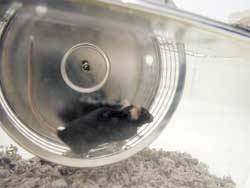Bipolar disorder causes a person's mood to cycle between manic and depressed mental states. Together with schizophrenia, these disorders are the two major psychoses, but psychiatrists tend to under-diagnosed bipolar disorder because the cyclical remission of the symptoms associated with this disorder. As we learn more, the prevalence of bipolar disorder is becoming more apparent.
As the patient oscillates between manic and depressive phases, he or she develops a heavy social handicap. Despite years of research, the causes of this disorder remain unknown. However, by exploring why lithium alleviates symptoms and differences in gene expression in twin studies in which only one twin is affected, we have found some clues.
We studied brain activity of bipolar patients using nuclear magnetic resonance imaging and noticed a relationship between mitochondrial diseases and this disorder. The drop in creatine phosphate levels or in pH in patients' brains resembled those seen in patients with mitochondrial diseases. In fact, reports of depression and bipolar-like mood changes in cases of mitochondrial disease (in which accumulations of mitochondrial DNA [mtDNA] deletions in the brain) are common.
There are also reports of accumulations of mtDNA deletions in the brains of patients diagnosed with bipolar disorder.
To confirm a possible connection between these deletions and mood disorders, we genetically engineered mice to have brain accumulations of mtDNA deletions and observed their behavior. mtDNA is inherited from the mother and polymerase γ, the enzyme that replicates it, is coded in the chromosome gene.
We introduced a single mutation into the gene of that enzyme so that the wrong mtDNA would be replicated only in the neural cells of our engineered animals. Even as these mtDNA deletions accumulated in the brains of our mice, we could not detect any abnormalities in their physical development, senses, movement, or memory formation.
The next step was to observe mood-like behaviors to determine whether each mouse showed symptoms of bipolar disorder.
While there is currently no protocol to determine whether an animal displays symptoms of bipolar disorder, we assumed that radical changes in their behavior, such as dramatic increases or decreasing in their voluntary wheel-running activity, over a prolonged period would reflect similar changes observed in bipolar patients.
Our male mice showed no fluctuations in movement, but our female mice did have periods of frequent wheel-running activity followed by periods of inactivity that lasted about five days. The changes coincided with their estrus cycle. Mice are nocturnal animals that usually sleep during the day; however, our mice were active during the day.
When given lithium, a drug commonly used to treat bipolar disorder, this daytime activity dropped. Conversely, when we gave the animals an antidepressant known to cause a manic-like state, the mice exhibited a manic-like state.
A lack of animal models for drug development and research into bipolar disorder has hindered development of new treatments for bipolar disorder. Our results suggest that these mice may function as an animal model for bipolar disorder research and might accelerate the development of effective new drugs for this disorder. In addition, these findings suggest that mtDNA deletions may contribute to the development of bipolar disorder.
Our hypothesis that mitochondrial functional disorder is involved in bipolar disorder is gaining international traction, in fact, developmental research into therapeutic treatments that act on the mitochondria are now underdevelopment in the United States.
Although more data needed to clarify mtDNA involvement in bipolar disorder, we feel that our results will trigger a breakthrough in this area.







